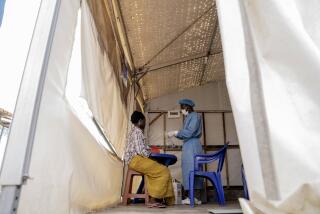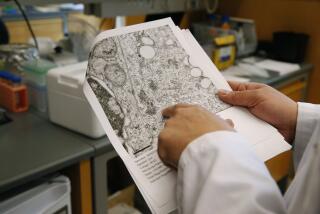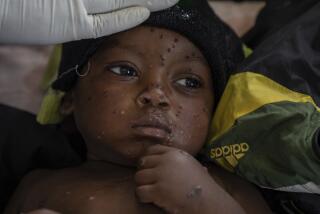Polio Cases Linked to Lack of Inoculations
A recent outbreak of polio in Haiti and the Dominican Republic was caused by a once-harmless vaccine strain of polio that was able to mutate back to virulence because most of the children in the region had not been immunized, according to a new report.
The so-called Sabin oral polio vaccine used in most developing nations employs weakened strains of three polio viruses to trigger the body’s immune system against the disease. It is usually harmless. But in this case, particles from one of the viruses apparently mutated and traded genetic material with a related human virus in a process that enabled the virus to once again become dangerous.
Because only about 30% of the children younger than 15 in the region had ever been vaccinated, the illness was able to spread, said Olen Kew, lead author of the multi-institution report and chief of molecular virology at the polio lab at the federal Centers for Disease Control and Prevention in Atlanta.
Ultimately, 20 cases of polio were confirmed, two of them fatal.
The vaccine involved differs from the Salk vaccine, used in the U.S., which is made with an inactivated virus. The Salk vaccine is far less practical for use in mass vaccinations in poor countries because it is costly and must be injected.
The finding about how the outbreak developed, published in the journal Science, shows what can happen if countries backslide in their immunization efforts--even when it appears that the natural, disease-causing virus has been eradicated from a region, public health officials said.
“It’s a very well-done study,” said Dr. Samuel Katz, professor of pediatrics at Duke University in Durham, N.C. “It shows that if you have susceptible children and the vaccine passes from child to child, even the vaccine virus becomes capable of causing paralysis.
“It means that eradicating polio is going to rely on very, very heavy immunization in areas that are currently very difficult to reach” because of poverty, war or civil strife, he said.
Poliomyelitis is an infectious disease caused by a virus that enters via the mouth, then invades the nervous system. It affects mostly young children. In 1 of 200 cases, the infection causes permanent paralysis. It can cause death if the muscles needed for breathing are immobilized.
A global effort to eradicate the virus by 2000 was launched in 1988, involving large-scale national immunization days in which many children were vaccinated together.
The number of cases of polio worldwide has dropped by 99% since 1988, according to the World Health Organization, and the number of countries where polio viruses are endemic has fallen from 120 to 10. Polio is now mostly a problem in sub-Saharan Africa and the Indian subcontinent.
The World Health Organization declared the Americas polio-free in 1994. Until the outbreak in Haiti and the Dominican Republic, which happened in 2000, the last-documented case in the Americas had been of a child in Peru in 1991.
When the new outbreak occurred, doctors at first feared that the wild virus had somehow been brought to the island from parts of the world where it is still endemic.
The truth turned out to be different.
Genetic typing of 31 virus samples tested by the CDC--some from the patients and others from those who had been in close contact with them--revealed that the virus was most closely related to one of the three weakened viruses used in the vaccine.
But while closely related, the viruses weren’t identical--as if they had originated from the vaccine but had somehow accumulated changes.
Some of those changes had randomly occurred over time through mistakes in the copying of the virus as it spread from person to person.
Other changes appear to have come from a back-and-forth trade of chunks of genetic material between the vaccine virus and related, gut-dwelling viruses called enteroviruses.
The end result was a restoration of the virus’ ability to spread and cause disease.
Similar outbreaks traced to partial vaccination occurred in the Philippines and Egypt in the last several years, underscoring the danger of vaccinating only part of the population, researchers said.
More to Read
Sign up for Essential California
The most important California stories and recommendations in your inbox every morning.
You may occasionally receive promotional content from the Los Angeles Times.










